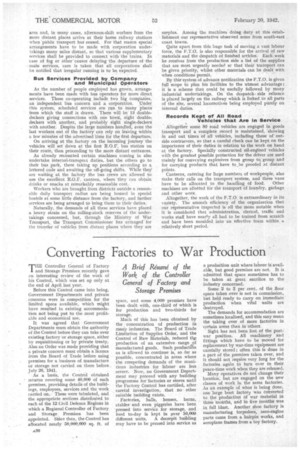Converting Factories to War Production
Page 32

If you've noticed an error in this article please click here to report it so we can fix it.
A Brief Résumé of the Work of the Controller General of Factory and Storage Premises THE Controller General of Factory and Storage Premises recently gave an interesting review of the work of his Control, which was set up only at the end of April last year.
Before this Control came into being, Government Departments and private concerns were in competition for the limited space available, which might have resulted in existing accommodation not being put to the most profitable and economical use.
It was agreed that Government Departments must obtain the authority of the Control before they can take over existing factory or storage space, either by requisitioning or by private treaty. Also an Order was made providing that a private concern must obtain a licence from the Board of Trade before using premises for a business of manufacture or storage not carried on there before July 26, 1941.
As a basis, the Control obtained returns covering some 40,000 of such premises, providing details of the buildings, employees, services and the work carried on. These were tabulated, and the appropriate sections distributed to each of the 12 Civil Defence Regions in which a Regional Controller of Factory. and Storage Premises has been appointed. Since then, the Control has allocated nearly 50,000,000 sq. ft. of
space, and some 4,000 premises have been dealt with, one-third of which is for production and two-thirds for storage.
Much of this has been obtained by the concentration 'of production in many industries. The Board of Trade Limitation of Supplies Order, and the Control of Raw Materials, reduced the production of an extensive range of manufactured goods. Such production as is allowed to continue is, so far as possible, concentrated in areas where the competing demands of the munitions industries for labour are less severe. Now, no Government Department may proceed with any building programme for factories or stores until the Factory Control has certified, after careful investigation, that no other suitable building exists.
Factories, halls, houses, barns, stables and even piggeries have been pressed into service for storage, and food to-day is kept in over 10,000
different units. A decrepit building may have to be pressed into service as a production unit where labour is available, but good premises are not. It is admitted that space sometimes has to be taken at great sacrifice to the industry concerned.
Some 2 to 3 per cent. of the floor space taken over is not in commission, but held ready to carry on immediate production when vital units are destroyed.
The demands for accommodation are sometimes localized, and this may mean the taking over of more factories in certain areas than in others.
Sight has not been lost of the postwar position. All machinery and fittings which have to be moved for replacement by war-time equipment are carefully stored ; often this is done in a part of the premises taken over, and it should not require very long for the factories again to turn over to their peace-time work when they are released. Many operatives do not change their location, but are engaged on the new classes of work in the same factories. As an example of what is being done, one large boot factory was converted to the production Of war material in three 'months, and in five months was in full blast. Another shoe factory is manufacturing torpedoes, aero-engine parts come from a hairpin works, and aeroplane frames from a toy factory.




















































